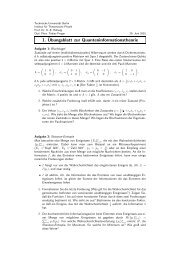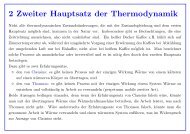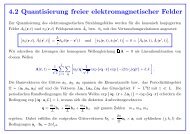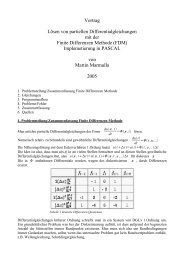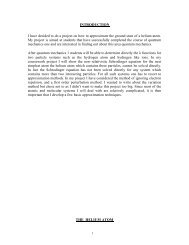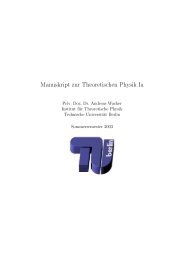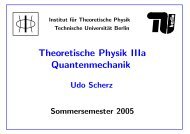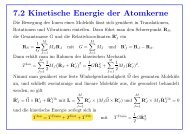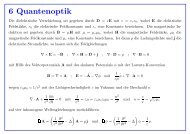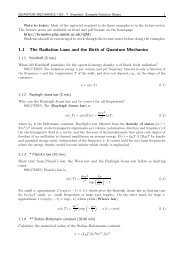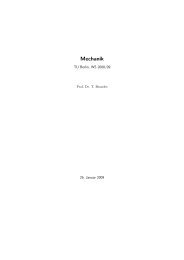2. SECOND ORDER LINEAR DIFFERENTIAL EQUATIONS
2. SECOND ORDER LINEAR DIFFERENTIAL EQUATIONS
2. SECOND ORDER LINEAR DIFFERENTIAL EQUATIONS
Create successful ePaper yourself
Turn your PDF publications into a flip-book with our unique Google optimized e-Paper software.
<strong>2.</strong>3. 2nd order homogeneous linear differential equations with constant coefficients II 19<br />
Remember that for p > 0 and q > 0 this corresponds to the differential equation<br />
Eq. (<strong>2.</strong>1) of the damped linear harmonic oscillator. We already know that this<br />
system performs oscillations ( sin, cos) that can be exponentially damped ( exp).<br />
Therefore, we expect something related to sin, cos, exp functions. But these are all<br />
related to each other if we recall what we have learned about complex numbers:<br />
exp(ix) = cos(x) + i sin(x), xreal<br />
cos(x) = eix + e−ix = Re[e<br />
2<br />
ix ]<br />
sin(x) = eix − e−ix = Im[e<br />
2i<br />
ix ]. (<strong>2.</strong>25)<br />
Furthermore, for arbitrary complex z = x + iy,<br />
e z = e x+iy = e x e iy = e x [cos(y) + i sin(y)] = e x cos(y) + ie x sin(y). (<strong>2.</strong>26)<br />
The function e z with complex z comprises the real exponential as well as sin and<br />
cos.<br />
Let us therefore try an exponential Ansatz in Eq. (<strong>2.</strong>24),<br />
y(x) = e zx y ′′ (x) + py ′ (x) + qy(x) = [z 2 + pz + q]e zx = 0. (<strong>2.</strong>27)<br />
We recognize that y(x) = e zx fulfills the differential equation, if the bracket [...] is<br />
zero:<br />
[z 2 + pz + q] = 0. (<strong>2.</strong>28)<br />
This is a quadratic equation which in general has two solutions,<br />
z 2 + pz + q = 0 z1/2 = − p<br />
2 ±<br />
<br />
p2 − q. (<strong>2.</strong>29)<br />
4<br />
<strong>2.</strong>3.1 Case p2<br />
4<br />
− q > 0<br />
In this case,<br />
z1/2 = − p<br />
2 ±<br />
<br />
p2 − q<br />
4<br />
(<strong>2.</strong>30)<br />
are both real and the two solutions fulfilling Eq. (<strong>2.</strong>24) are<br />
p2 4 − q > 0 y1(x)<br />
p<br />
[−<br />
= y1e 2 +<br />
The general solution is the linear combination of the two,<br />
p2 4 −q]x p<br />
[−<br />
, y2(x) = y2e 2 −<br />
p 2<br />
4 −q]x<br />
(<strong>2.</strong>31)<br />
p2 p<br />
[−<br />
− q > 0 y(x) = y1e 2<br />
4 +<br />
p2 4 −q]x p<br />
[−<br />
+ y2e 2 −<br />
p2 4 −q]x . (<strong>2.</strong>32)<br />
In this case there are no oscillations at all. The ‘damping term’ py ′ (x) is too strong.




